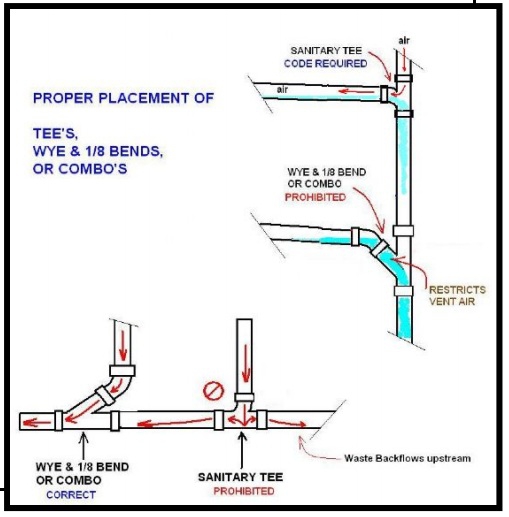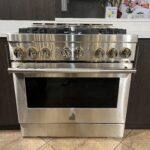When it comes to plumbing, every little component plays a crucial role in ensuring your systems work efficiently and without hiccups. If you’ve ever found yourself confused between choosing a sanitary tee and a wye, you’re not alone.
These two fittings may seem similar, but they serve distinct purposes that can impact the effectiveness of your plumbing setup. Imagine saving time, money, and potential headaches by simply understanding the differences between these two essential tools. We’ll break down everything you need to know about sanitary tees and wyes, so you can make informed decisions for your home or business.
Ready to dive in and make your plumbing system the best it can be? Let’s get started!

Credit: www.reddit.com
Sanitary Tee Overview
Choosing the right fitting for plumbing is essential. A sanitary tee plays a crucial role in drainage systems. It connects horizontal and vertical pipes efficiently. Understanding its design and applications aids in making informed decisions. Proper installation ensures smooth wastewater flow.
Design And Structure
The sanitary tee features a T-shaped design. It has three openings for pipe connections. The top and bottom openings align vertically. The third opening connects at a perpendicular angle. This design promotes efficient waste flow. It reduces blockage risk in plumbing systems. The structure aids in venting gases. Its smooth interior minimizes friction.
Common Applications
Sanitary tees are common in residential plumbing. They connect drain pipes to vent stacks. These fittings are vital in bathroom setups. They handle wastewater from sinks and showers. In kitchens, they connect to dishwashers and sinks. Their design supports proper airflow in systems. They help prevent pressure build-up in pipes.

Credit: www.doityourself.com
Wye Fitting Basics
Choosing between a sanitary tee and a wye fitting is crucial in plumbing. A sanitary tee connects horizontal and vertical pipes. A wye fitting, shaped like a “Y,” smoothly joins pipes at a 45-degree angle. Each serves specific needs in efficient drainage systems.
When it comes to plumbing, choosing the right fitting can make all the difference. Whether you’re a homeowner or a professional plumber, understanding the basics of a wye fitting can help you make informed decisions. Have you ever wondered how a wye fitting can streamline your plumbing system? Let’s dive into the essential aspects of this versatile component.Design And Structure
A wye fitting, unlike a sanitary tee, boasts a unique Y-shaped design. This configuration allows for a smoother flow of liquids. The angle of the arms typically meets at 45 degrees, promoting efficient movement. This design reduces the chances of clogs and blockages, making it an excellent choice for systems with high flow rates. The structure is straightforward but powerful. Its simplicity is its strength, offering a no-nonsense solution that fits easily into various plumbing setups. Have you ever seen a wye fitting in action? Its design ensures that waste is directed efficiently, minimizing potential plumbing issues.Common Applications
You might be wondering where you can use a wye fitting. They’re commonly found in drainage systems where smooth flow is critical. They are perfect for connecting horizontal drain lines to vertical ones. This helps in directing waste efficiently, avoiding the pitfalls of backflow. In residential plumbing, wye fittings are often used to connect drainpipes from different fixtures. Have you ever tried to combine kitchen and bathroom drainage? A wye fitting can be the answer, ensuring a seamless connection. In commercial settings, these fittings are used in larger systems to handle increased flow rates. They can be a lifesaver in preventing clogs in busy environments. Why not consider a wye fitting for your next plumbing project? Choosing between a sanitary tee and a wye can be daunting. But with these insights into the wye fitting basics, you’re better equipped to make an informed choice. What will you choose for your plumbing needs?Key Differences
Sanitary tees and wyes serve different purposes in plumbing systems. Sanitary tees connect horizontal and vertical pipes, ideal for drainage. Wyes, on the other hand, join pipes at a gentle angle, promoting smooth flow. Each plays a unique role in maintaining efficient water movement.
When working on plumbing projects, understanding the differences between a sanitary tee and a wye is crucial. These components may seem similar but serve distinct purposes in your plumbing system. Knowing their key differences can prevent costly mistakes and ensure your plumbing functions smoothly.Functional Variations
A sanitary tee is designed to connect a horizontal drain line to a vertical one. It’s ideal for creating right-angle connections. This component is often used in venting applications because it allows air to pass through while directing water flow downward. On the other hand, a wye is shaped like the letter ‘Y’. It connects two pipes at a 45-degree angle, promoting a smooth flow of water. This makes it perfect for joining two horizontal lines or connecting a horizontal line to a vertical one with minimal resistance. Consider the flow you need in your system. A wye offers less turbulence, making it suitable for areas where clogging is a concern. The sanitary tee, however, is your go-to for venting needs. Choose based on the specific function required in your plumbing setup.Installation Requirements
Installing a sanitary tee requires careful alignment to ensure the correct flow direction. Make sure it is positioned so that the horizontal line feeds into the vertical line. Incorrect installation can lead to blockages or improper venting. With a wye, alignment is slightly more forgiving. Its angled design naturally guides the flow, reducing the risk of clogs. It is essential to secure the wye properly to avoid leaks and ensure stability in your plumbing system. Think about your installation space. A sanitary tee might need more vertical space, while a wye can fit in tighter horizontal areas. Knowing the spatial requirements can help you avoid unnecessary adjustments later on. By understanding these differences, you can make informed choices that improve your plumbing system’s efficiency. Have you ever faced a plumbing challenge where knowing the difference between these fittings would have helped? Share your experiences and learn from others in the comments below!Advantages Of Sanitary Tee
Sanitary tees offer better drainage for vertical pipes compared to wyes. They are ideal for connecting horizontal and vertical lines. Their design helps prevent clogs and promotes smooth flow.
When considering plumbing systems, the choice between a sanitary tee and a wye can significantly impact your project’s success. While both fittings serve essential roles, the sanitary tee has distinct advantages that can make your work more efficient and hassle-free. Let’s delve into how choosing a sanitary tee can enhance your plumbing projects.Efficiency In Waste Management
A sanitary tee is designed to effectively manage waste flow, ensuring that water and waste move smoothly through your plumbing system. Its unique T-shape allows for a straight path with a side outlet, which minimizes turbulence and reduces the risk of clogging. Imagine working on a project where seamless waste management is crucial. The sanitary tee’s design can save you from frequent maintenance and potential blockages, sparing you the frustration of unexpected plumbing issues.Ease Of Installation
Installing a sanitary tee is straightforward, making it a popular choice among DIY enthusiasts and professionals alike. Its design simplifies the process, reducing the time and effort needed for installation. Think about the last time you tackled a plumbing job. Wouldn’t it be great if you could complete it quickly without compromising quality? With a sanitary tee, you can achieve just that, thanks to its user-friendly design that even beginners can handle with confidence. Choosing the right plumbing fitting can be daunting. But understanding the advantages of a sanitary tee can guide you toward making informed decisions that lead to successful and efficient outcomes. Are you ready to enhance your plumbing projects with the right tools?Advantages Of Wye Fitting
Wye fittings offer a smoother flow for wastewater, reducing blockages compared to sanitary tees. Their angled design minimizes turbulence, enhancing drainage efficiency. Ideal for plumbing systems where seamless water flow is crucial.
When choosing between a sanitary tee and a wye fitting for your plumbing needs, understanding the advantages of each can make a significant difference in your project’s success. A wye fitting, in particular, offers several benefits that can streamline your plumbing tasks, making it a preferred choice for many professionals. Let’s dive into some of the key advantages of using a wye fitting.Enhanced Flow Direction
A wye fitting is designed to provide a smoother flow path for liquids and waste materials. Its angled design helps guide the contents through the piping system with minimal resistance. This can be particularly beneficial if you’re dealing with high-flow applications or attempting to reduce potential clogs. Imagine a scenario where you’ve just installed a new plumbing system in your home. You notice that the water drains faster and more efficiently, thanks to the wye fitting’s ability to direct flow seamlessly. This improved flow direction can save you time and headache down the line.Space Efficiency
Wye fittings are often more space-efficient compared to their counterparts. Their compact design allows them to fit into tighter spaces, which is crucial if you’re working with limited room. This can be a game-changer in small bathrooms or cramped basements where every inch counts. Think about the last time you struggled to fit plumbing components into a small space. A wye fitting can reduce that hassle, enabling you to make the most of your available space. It ensures that your plumbing system remains functional without unnecessary bulk or complications. Considering these advantages, have you thought about how a wye fitting could simplify your next plumbing project? Could it be the solution you need for efficient and effective plumbing?
Credit: www.facebook.com
Choosing The Right Fitting
Selecting the right fitting involves understanding the differences between a sanitary tee and a wye. Sanitary tees are ideal for horizontal to vertical transitions, while wyes offer smoother angles for better flow in horizontal lines. Each fitting serves specific purposes in plumbing systems.
Choosing the right fitting for your plumbing project can be a daunting task. You might be asking yourself whether a sanitary tee or a wye is the best option. Each fitting has its unique advantages, but your choice should depend on specific factors. Let’s dive into what you need to consider when making this decision.Project Requirements
Your project requirements are crucial when selecting between a sanitary tee and a wye. A sanitary tee is ideal for vertical connections where wastewater transitions from a horizontal to a vertical pipe. It’s designed to prevent unwanted backflow—an essential feature for many household plumbing systems. On the other hand, a wye fitting is perfect for connecting horizontal pipes. It provides a smoother flow, minimizing the risk of clogs. If you’re working on a project requiring a horizontal pipe connection with minimal resistance, a wye might be your best bet. Consider what type of connection your project demands, and choose accordingly.Cost Considerations
Cost is another important factor in choosing the right fitting. Sanitary tees are generally less expensive than wyes. If you’re on a tight budget, opting for a sanitary tee could save you money without sacrificing functionality. However, investing a little more in a wye can pay off in the long run. Its ability to maintain a smooth flow can reduce maintenance costs associated with clogs or slow drainage. Weigh the initial investment against potential future savings. Could spending a bit more now save you headaches down the road? Ultimately, your decision should align with your project’s needs and budget. Consider practicalities, not just price, to ensure a hassle-free plumbing experience.Frequently Asked Questions
What Is The Difference Between A Sanitary Tee And A Wye?
A sanitary tee connects pipes at a right angle. A wye joins pipes at a 45-degree angle.
Which Is Better For Horizontal Drain Lines?
A wye is preferred for horizontal drain lines. It allows smoother flow, reducing blockage chances.
Can I Use A Sanitary Tee For Vent Pipes?
Yes, a sanitary tee is suitable for vent pipes. It provides proper air circulation in plumbing.
Is A Wye Fitting Good For Waste Lines?
Yes, a wye fitting is ideal for waste lines. It ensures efficient waste flow with minimal resistance.
When Should I Use A Sanitary Tee?
Use a sanitary tee when connecting vertical pipes. It is designed for vertical to horizontal transitions.
Conclusion
Choosing between a sanitary tee and wye depends on your plumbing needs. Sanitary tees fit well in vertical drainage systems. They direct waste efficiently. Wyes are ideal for horizontal connections. They allow smoother flow and reduce clogs. Consider your installation space.
Assess the direction of flow. Each tool has its specific use. Understand your plumbing system. Make informed decisions. Consult a professional if unsure. Proper choice ensures system efficiency. Avoid costly mistakes with the right fitting. Happy plumbing, and keep your systems running smoothly!



